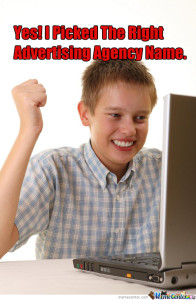 A Strategic Guide To How To Find Your New Advertising Agency Name
A Strategic Guide To How To Find Your New Advertising Agency Name
This is Part One of a two-part series on how to name your advertising agency (or, most businesses for that matter).
Other than the gyrations that agencies constantly go through with how to position their agency (go here to see my advice on agency positioning); design and redesign their website… how they name themselves is one of their most important branding decisions.
I worked for three advertising agencies. Two were “founder” agencies: Dancer Fitzgerald Sample (remember “Where’s the beef?”) and Saatchi & Saatchi (which bought Dancer) and the other was my very own Portland agency and its “current usage” name: Citrus. Or, as one of our creative directors thought was critical to our success, citrus, with a lower case “c.’
A Question…
Do advertising names matter? Wow, this is a tough one to answer. As you will see from the different naming conventions listed below, how one chooses a name is a broad journey. However, just for the hell of it, here are some of the names for AdAge’s 2018 Small Agency Awards. Do any of these agency names instill immediate confidence? A must call reaction? Are memorable?
- Butler, Shine, Stern & Partners
- Mistress
- Johnxhannes
- The Chopping Block
- Funworks
- Oberland
- Walrus (cool website)
- Phenomenon
- Brownstein Group
- Steak
- Yard
- G&M Plumbing
- Spawn ideas
- Next/Now
My favorite (at least for this one second) is Next/Now. This name kind of meets a client pain point.
Part One: The Wonderful World of the Advertising Agency Name
I recently asked one of my advertising agency clients how they selected their name (note, it’s a word you use every day in your kitchen.) They said that they went through a fairly random process with the goal of finding a name that was easy to remember and not taken. Well, that’s one way to do it. Another is to apply process.
Before I begin to riff on how to name an advertising agency, I feel the need to list some of the crazier ad agency names. Here you go:
Steak / Big Spaceship / Wexley School For Girls / Farm / Mooseylvania / Space 150 / Sasquatch / Heresy / Poke / Droga5 / Barton F. Graf 9000 / Mekanism / 72andSunny / Mistress / G&M PLumbing / Almighty / TKO
You get the idea.
A Few Words On Naming An Advertising Agency
Powerful product and service names add significant value to branding, marketing and business development programs. Powerful brand names are often the most efficient method in creating market differentiation, telegraphing a brand’s positioning, its uniqueness and act as a tool in building a strong customer to brand connection.
- The right brand names add value: for the consumer, employees and corporate valuation.
- Brand names position the product or service in the minds of the prospect.
- Brand names create differentiation.
- Brand names telegraph service quality and trust. In the case of agencies… creativity.
- Some brand names have visual appeal.
- Brand names can create an emotional connection.
- A great brand name communicates brand-related messages to the consumer with far less marketing effort.
- Good brand names are easier to remember than bad brand names.
- Make it easy. Search consultants need all the help they can get.
Having a brand name that does none of the above is a wasted opportunity.
How do we know this?
Much of it is intuitive. It is my view that a memorable and communicative brand name simply makes sense. That having a name that is suggestive and supportive of service or product attributes helps to drive differentiation. That having a strong brand name that actually sinks into our skulls is a good thing. Think of brand names as people: Vladimir conjures up very different imagery than Simon or Jacques or Manny. It works for products and services too. Vladimir Vodka I get. Manny Vodka just doesn’t cut it. Um, maybe for Rosh Hashanah.
There Are Five Essential Types Of Brand Names
1. Neologisims
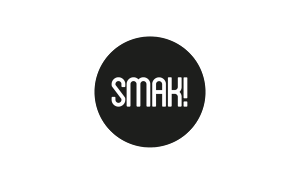 A neologism, or new word, is just what you would expect it to be – a word that is created.
A neologism, or new word, is just what you would expect it to be – a word that is created.
Pros: New inventive products can make the new name synonymous with their product (XEROX, Kleenex, Microsoft, eTrade), they are distinctive and are globally friendly. No legal or copyright issues.
Cons: Neologisms have no meaning and initially take more marketing power to become recognized, there is a missed opportunity to position the service by its name’s meaning, there can be spelling and pronunciation errors. It is occasionally difficult to get corporate committees to agree on a neologism – decision making is subjective.
SMAK! is a French design firm and SMAK! works for me and crosses borders.
2. Current Usage Words
 Current Usage Words already have meaning. Brands with Current Usage names include Oracle, Sprint, Apple, Tide and Fidelity.
Current Usage Words already have meaning. Brands with Current Usage names include Oracle, Sprint, Apple, Tide and Fidelity.
Pros: Current Usage Names telegraph Brand values (Apple is friendly), tap the name’s inherent attributes (Sprint is fast), can quickly trigger positive imagery (Tide is fresh and clean) and communicate service messages with less marketing spending.
Cons: Marketers must make sure that Current Usage Names accurately reflect the Brand’s image and do not raise a negative or confusing response. There may be trademark hurdles. An additional issue can arise when a company decides to change positioning or add new products that might not be consistent with the existing name.
gyro. I’m thinking gyroscope not lamb. But, an Athens office could pose a linguistic problem.
3. Hybrids
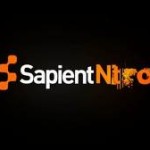 Hybrids combine Current Usage Names. I am currently typing on a ThinkPad laptop and I brushed my teeth with AquaFresh. I just played with a PlayStation.
Hybrids combine Current Usage Names. I am currently typing on a ThinkPad laptop and I brushed my teeth with AquaFresh. I just played with a PlayStation.
Pros: Hybrids are similar to Current Usage Names in that they quickly communicate a brand message. In addition, the combination can build on the power of the two-word combination. Finally, Hybrids reduce the issues associated with copyrighting the name.
Cons: The cons are similar to those of Current Usage Names.
SapientNitro sounds big.
4. Acronyms
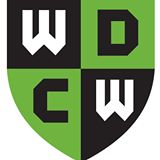 Acronyms are letter combinations that generally reflect a multiple word name. In many cases, the Acronym has taken the place of the original name (IBM was for the older generation a company called International Business Machines).
Acronyms are letter combinations that generally reflect a multiple word name. In many cases, the Acronym has taken the place of the original name (IBM was for the older generation a company called International Business Machines).
Many Acronyms have traditionally been in heavy use by technology and engineering firms because of their functional origin (GE, AT&T, CBS).
Pros: Acronyms can be distinctive and have few legal issues.
Cons: Acronyms require marketing to make them memorable, they have little inherent meaning and since they essentially say nothing about the Brand, they add little value to the customer branding experience. They can also be hard to remember.
That’s Wong Doody Crandle Weiner to you.
5. Founder Names
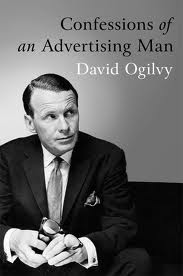 Founder names abound across many service and product categories. Ford, Sony, Chase, Jensen, and Schwab all are names of company founders. Many brands that want to engender trust, for example in the financial services category, use Founder Names.
Founder names abound across many service and product categories. Ford, Sony, Chase, Jensen, and Schwab all are names of company founders. Many brands that want to engender trust, for example in the financial services category, use Founder Names.
Pros: Using the Founder’s name adds direct personal credibility. In a case where the founder is already well known, the Founder name comes with immediate recognition and value as in the case of Martha Stewart Living Magazine.
Cons: In most cases using a Founder name requires significant marketing expenditures to seed the name. Founder Names do not add much initial value.
Ogilvy just might be the most famous name in advertising.
Now Go Here -> Part Two: Process
I am a fan of having a reasonable process. In the case of agency names, the application of a bit of strategic thinking that is based on the agency’s brand position (which, by the way, is a good place to start.)
Now, that said, agency naming can be a very random process and one that is often a crap shoot. If you think of some of today’s leading advertising agencies (RG/A; 72andSunny; Rokkan and Firstborn) you could make a case for not getting too crazed about what to name your ad agency. But, hey…
Head over to Part Two to see my recommended naming process – the art of process is a good thing… It will deliver that business building advertising name
—-
If you DUG this information, then you should head over to Amazon and buy:
The Levitan Pitch. Buy This Book. Win More Pitches.
“Okay, am only on page 23 and am laughing out loud and was so engrossed I was 5 minutes late dialing into a conference call…”
Renee

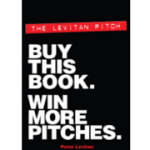
Hi Peter, thank you for your words of wisdom. Did make me laugh. What i find very challenging is coming up of a name for your own brand agency. I can do with the help.